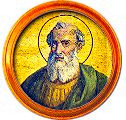Under Islamic conquests and rule
Archaeological and scholarly research has shown that Christianity existed after the Muslim conquests, though the Catholic church gradually declined along with local Latin dialect. [9] [10]
Many causes have been seen as to leading to the decline of Christianity in Maghreb. One of them is the constant wars and conquests as well as persecutions. In addition many Christians also migrated to Europe. The Church at that time lacked the backbone of a monastic tradition and was still suffering from the aftermath of heresies including the so-called Donatist heresy, and that this contributed to the early obliteration of the Church in the present day Maghreb. Some historians contrast this with the strong monastic tradition in Coptic Egypt, which is credited as a factor that allowed the Coptic Church to remain the majority faith in that country until around after the 14th century despite numerous persecutions. In addition, the Romans and the Byzantines were unable to completely assimilate the indigenous people like the Berbers. [11] [12]
Another view is that Christianity in North Africa ended soon after conquest of North Africa by the Islamic Umayyad Caliphate between AD 647–709 effectively. [13] However, new scholarship has appeared that disputes this. There are reports that Christianity persisted in the region from Tripolitania (present-day western Libya) to present-day Morocco for several centuries after the completion of the Arab conquest by 700. A Christian community is recorded in 1114 in Qal'a in central Algeria. There is also evidence of religious pilgrimages after 850 to tombs of Christian saints outside of the city of Carthage, and evidence of religious contacts with Christians of Arab Spain. In addition, calendrical reforms adopted in Europe at this time were disseminated amongst the indigenous Christians of Tunis, which would have not been possible had there been an absence of contact with Rome.
Local Catholicism came under pressure when the Muslim fundamentalist regimes of the Almoravids and especially the Almohads came into power, and the record shows persecutions and demands made that the local Christians of Tunis to convert to Islam. We still have reports of Christian inhabitants and a bishop in the city of Kairouan around 1150 – a significant report, since this city was founded by Arab Muslims around 680 as their administrative center after their conquest. A letter from the 14th century shows that there were then still four bishoprics left in North Africa, albeit a sharp decline from the over four hundred bishoprics in existence at the time of the Arab conquest. [14] Berber Christians continued to live in Tunis and Nefzaoua in the south of Tunisia until the early 15th century, and "[i]n the first quarter of the fifteenth century, we even read that the native Christians of Tunis, though much assimilated, extended their church, perhaps because the last of the persecuted Christians from all over the Maghreb had gathered there." They were not in communion with the Catholic church of that time, however. [15]
Another group of Christians who came to North Africa after being deported from Islamic Spain were called the Mozarabs. They were recognised as forming the Moroccan Church by Pope Innocent IV. [16]
Christians in Morocco had mostly become slaves by the time of Ibn al-Ahmar and Ferdinand III of Castile. Celestine III had told Toledo's archbishop Martin to dispatch a priest for Christians in Morocco. Innocent III in 1198 requested the Almohads to allow the Trinitarian Order to perform its duties and in 1200 wrote a letter to the Christians enslaved there. Rebel Castilians had also served the Almohad caliphs and resided in Morocco. Pope Honorius III had requested the Almohads to allow the Christians to freely practice their faith. [17] In June 1225, Honorius III issued the bull Vineae Domini custodes that permitted two friars of the Dominican Order named Dominic and Martin to establish a mission in Morocco and look after the affairs of Christians there. [18] The friars of Francis of Assisi were dispatched to Morocco to evangelize to the Muslims but were killed. [17]
Honorius III on 20 February 1226 told Rodrigo Jiménez de Rada to dispatch Franciscans to convert the Moroccan Muslims. This mission had proved very difficult due to the fact that Christianity was widely dispersed in the region. The first known bishop of Morocco was appointed by Pope Gregory IX on 12 June 1237. The sultan Abd al-Wahid II in 1233 received a letter from the Pope referring to Bishop Agnello as the bishop of Fez. Lope Fernandez de Ain was appointed as the bishop of Morocco but wasn't able to establish himself before the Marinids captured Fez in 1248. Innocent IV had named him bishop of Church of Africa on 19 December 1246. [19]
The medieval Moroccan historian Ibn Abi Zar stated that the Almohad caliph Abu al-Ala Idris al-Ma'mun had built a church in Marrakech for the Christians to freely practice their faith at Fernando III's insistence. Innocent IV asked emirs of Tunis, Ceuta and Bugia to permit Lope and Franciscian friars to look after the Christians in those regions. He thanked the Caliph al-Sa'id for granting protection to the Christians and requested to allow them to create fortresses along the shores, but the Caliph rejected this request. [17] García Peréz was the archdeacon of Morocco during 1250s, but the local church was unable to support him and he had to depend on the Castilian church. [20]
Before the Portuguese conquest of Ceuta, Franciscans were established there. A document dated 10 March 1413 shows that the Antipope John XXIII had chosen Aimary de Aurrilac as the bishop of Morocco in place of Fray Diego de Jerez. [21]






